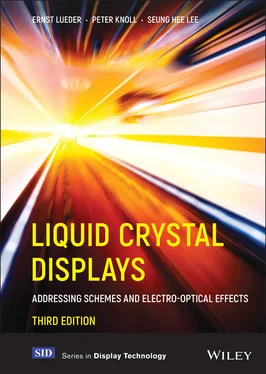Ernst Lueder - Liquid Crystal Displays
Здесь есть возможность читать онлайн «Ernst Lueder - Liquid Crystal Displays» — ознакомительный отрывок электронной книги совершенно бесплатно, а после прочтения отрывка купить полную версию. В некоторых случаях можно слушать аудио, скачать через торрент в формате fb2 и присутствует краткое содержание. Жанр: unrecognised, на английском языке. Описание произведения, (предисловие) а так же отзывы посетителей доступны на портале библиотеки ЛибКат.
- Название:Liquid Crystal Displays
- Автор:
- Жанр:
- Год:неизвестен
- ISBN:нет данных
- Рейтинг книги:4 / 5. Голосов: 1
-
Избранное:Добавить в избранное
- Отзывы:
-
Ваша оценка:
- 80
- 1
- 2
- 3
- 4
- 5
Liquid Crystal Displays: краткое содержание, описание и аннотация
Предлагаем к чтению аннотацию, описание, краткое содержание или предисловие (зависит от того, что написал сам автор книги «Liquid Crystal Displays»). Если вы не нашли необходимую информацию о книге — напишите в комментариях, мы постараемся отыскать её.
THE NEW EDITION OF THE GOLD-STANDARD IN TEACHING AND REFERENCING THE FUNDAMENTALS OF LCD TECHNOLOGIES
Liquid Crystal Displays — читать онлайн ознакомительный отрывок
Ниже представлен текст книги, разбитый по страницам. Система сохранения места последней прочитанной страницы, позволяет с удобством читать онлайн бесплатно книгу «Liquid Crystal Displays», без необходимости каждый раз заново искать на чём Вы остановились. Поставьте закладку, и сможете в любой момент перейти на страницу, на которой закончили чтение.
Интервал:
Закладка:
 perpendicular to
perpendicular to  Figure 2.5 Helix of the cholesteric phase Figure 2.6 The rotational viscosity for rotation of a molecule perpendicular to the director Figure 2.7 Equilibrium configuration; the elastic deformations splay (a), twist (b) and bend (c) Figure 2.8 The basic structure of a calamitic LC molecule Figure 2.9 Top view of the rows, columns, pixels and contact pads of a display panel Figure 2.10 The structure of a TN-LCD (a) while light is passing, and (b) while light is blocked, a: polarizer; b: glass substrate; c; transparent electrode; g; orientation layer; e: liquid crystal; f: illumination Figure 2.11 LC molecules with pretilt angle a 0on top of the orientation layer Figure 2.12 Change in the position of the LC molecules with increasing voltage Figure 2.13 Transmitted luminance versus the reduced voltage V LCacross the LC cell for the normally white and normally black modes Figure 2.14 The geometrical arrangement of colour pixels for red R, green G, and blue B (a) in triangles, (b) in stripes and (c) in diagonal form Figure 2.15 Cross-section of a colour filter for TFT addressed LCDs Figure 2.16 TFT addressing of the pixels in a row Figure 2.17 Waveform of the voltage across a pixel during charging and discharge of the storage capacitor
Figure 2.5 Helix of the cholesteric phase Figure 2.6 The rotational viscosity for rotation of a molecule perpendicular to the director Figure 2.7 Equilibrium configuration; the elastic deformations splay (a), twist (b) and bend (c) Figure 2.8 The basic structure of a calamitic LC molecule Figure 2.9 Top view of the rows, columns, pixels and contact pads of a display panel Figure 2.10 The structure of a TN-LCD (a) while light is passing, and (b) while light is blocked, a: polarizer; b: glass substrate; c; transparent electrode; g; orientation layer; e: liquid crystal; f: illumination Figure 2.11 LC molecules with pretilt angle a 0on top of the orientation layer Figure 2.12 Change in the position of the LC molecules with increasing voltage Figure 2.13 Transmitted luminance versus the reduced voltage V LCacross the LC cell for the normally white and normally black modes Figure 2.14 The geometrical arrangement of colour pixels for red R, green G, and blue B (a) in triangles, (b) in stripes and (c) in diagonal form Figure 2.15 Cross-section of a colour filter for TFT addressed LCDs Figure 2.16 TFT addressing of the pixels in a row Figure 2.17 Waveform of the voltage across a pixel during charging and discharge of the storage capacitor
2 Chapter 3 Figure 3.1 The plane A in which a planar wave travels with speed c 1and wave vector  parallel to the normal
parallel to the normal  Figure 3.2 The phasor P 0representing the vector E of an electrical field Figure 3.3 Rotation of the ξ − η coordinates by a into the x-y coordinates Figure 3.4 (a) Top view of Fréedericksz cell with direction of LC molecules and vector E of electric field; (b) cross section of LC cell with parallel layers of molecules and wave vectors k, kx and ky Figure 3.5 The ellipse as locus for the vector of the electric field Figure 3.6 Right- and left-handed elliptically polarized light seen against the propagating wave with wave vector k .
Figure 3.2 The phasor P 0representing the vector E of an electrical field Figure 3.3 Rotation of the ξ − η coordinates by a into the x-y coordinates Figure 3.4 (a) Top view of Fréedericksz cell with direction of LC molecules and vector E of electric field; (b) cross section of LC cell with parallel layers of molecules and wave vectors k, kx and ky Figure 3.5 The ellipse as locus for the vector of the electric field Figure 3.6 Right- and left-handed elliptically polarized light seen against the propagating wave with wave vector k .  viewing against the arrow of k Figure 3.7 Elliptical, circular and linear polarization for different phase differences δ = 2π(Δ n / λ )z (Reproduced from Born and Wolf, 1980 with permission of Elsevier.) Figure 3.8 Angles of polarizer and analyser for the Fréedericksz cell Figure 3.9 The intensity Iy , of the Fréedericksz cell for two values of α in Equation (3.73) Figure 3.10 The intensity Ix , of the Fréedericksz cell for two values of α in Equation (3.72) Figure 3.11 The angles of the electric field and the polarizers in a normally white Fréedericksz cell with linearly polarized light at the output d = λ/ 2Δ n . (a) Crossed polarizers; (b) parallel polarizers Figure 3.12 The reflective Fréedericksz cell. (a) Cross-section; (b) top view; (c) explanation of the operation of a reflective cell in the field-free state Figure 3.13 An LCD used as an SLM operating as a multiplier Figure 3.14 | Jzξ | in Equation (3.88) plotted versus α and z Figure 3.15 The linearly polarized light in parallel (α = 0) to the projection of the long axis of the LC molecules into the x-y plane Figure 3.16 Measured phase-shift curves of a Fréedericksz cell Figure 3.17 The DAP cell or Vertically Aligned (VA) cell in the field-free state Figure 3.18 The sputtering of an SiO 2orientation layer under an oblique angle of 70° Figure 3.19 The reflective HAN cell. (a) Cross-section; (b) optical anisotropy An(z) Figure 3.20 The operation of a reflective HAN cell. (a) In the field-free state; (b) if a voltage is applied Figure 3.21 The pretilt angles and the relaxation to the off-state. (a) Of a TN cell; (b) of a π cell Figure 3.22 The electro-optical response to a square voltage pulse. (a) Of a TN cell with a prolonged relaxation; and (b) of a π cell with a fast relaxation Figure 3.23 The anchoring of LC molecules at z = 0 and z = d Figure 3.24 Normalized rise time T mversus normalized voltage V nwith various tilt angles θd and θ 0 . (a) For p -type and (b) n -type nematic LCs Figure 3.25 Normalized rise time T mversus normalized voltage V nwith the ratio K of elastic constants as parameter (a) for p -type and (b) n -type nematic LCs Figure 3.26 The ratio T dnin Equation (3.110) versus K for a p -type nematic LC Figure 3.27 The ratio T dnin Equation (3.111) versus K for an n -type nematic LC Figure 3.28 An LC cell with (a) the isotropic blue phase when the field is off and (b) the anisotropic phase when the field is on. This figure was reproduced from Yang, Y. C. et al., SID 09 , p. 586 with permission by The Society for Information Display Figure 3.29 Phase diagram of chiral nematic LCs with blue phases BP I and BP II. This figure was reproduced from Kikuchi, H. et al., SID 09 , p. 580 with permission by The Society for Information Display Figure 3.30 Response time of the PSI-mode. This figure was reproduced from Yang, Y. C. et al., SID 09 , p. 589 with permission by The Society for Information Display Figure 3.31 Transmittance versus voltage of the PSI-mode. This figure was reproduced from Yang, Y. C. et al., SID 09 , p. 588 with permission by The Society for Information Display
viewing against the arrow of k Figure 3.7 Elliptical, circular and linear polarization for different phase differences δ = 2π(Δ n / λ )z (Reproduced from Born and Wolf, 1980 with permission of Elsevier.) Figure 3.8 Angles of polarizer and analyser for the Fréedericksz cell Figure 3.9 The intensity Iy , of the Fréedericksz cell for two values of α in Equation (3.73) Figure 3.10 The intensity Ix , of the Fréedericksz cell for two values of α in Equation (3.72) Figure 3.11 The angles of the electric field and the polarizers in a normally white Fréedericksz cell with linearly polarized light at the output d = λ/ 2Δ n . (a) Crossed polarizers; (b) parallel polarizers Figure 3.12 The reflective Fréedericksz cell. (a) Cross-section; (b) top view; (c) explanation of the operation of a reflective cell in the field-free state Figure 3.13 An LCD used as an SLM operating as a multiplier Figure 3.14 | Jzξ | in Equation (3.88) plotted versus α and z Figure 3.15 The linearly polarized light in parallel (α = 0) to the projection of the long axis of the LC molecules into the x-y plane Figure 3.16 Measured phase-shift curves of a Fréedericksz cell Figure 3.17 The DAP cell or Vertically Aligned (VA) cell in the field-free state Figure 3.18 The sputtering of an SiO 2orientation layer under an oblique angle of 70° Figure 3.19 The reflective HAN cell. (a) Cross-section; (b) optical anisotropy An(z) Figure 3.20 The operation of a reflective HAN cell. (a) In the field-free state; (b) if a voltage is applied Figure 3.21 The pretilt angles and the relaxation to the off-state. (a) Of a TN cell; (b) of a π cell Figure 3.22 The electro-optical response to a square voltage pulse. (a) Of a TN cell with a prolonged relaxation; and (b) of a π cell with a fast relaxation Figure 3.23 The anchoring of LC molecules at z = 0 and z = d Figure 3.24 Normalized rise time T mversus normalized voltage V nwith various tilt angles θd and θ 0 . (a) For p -type and (b) n -type nematic LCs Figure 3.25 Normalized rise time T mversus normalized voltage V nwith the ratio K of elastic constants as parameter (a) for p -type and (b) n -type nematic LCs Figure 3.26 The ratio T dnin Equation (3.110) versus K for a p -type nematic LC Figure 3.27 The ratio T dnin Equation (3.111) versus K for an n -type nematic LC Figure 3.28 An LC cell with (a) the isotropic blue phase when the field is off and (b) the anisotropic phase when the field is on. This figure was reproduced from Yang, Y. C. et al., SID 09 , p. 586 with permission by The Society for Information Display Figure 3.29 Phase diagram of chiral nematic LCs with blue phases BP I and BP II. This figure was reproduced from Kikuchi, H. et al., SID 09 , p. 580 with permission by The Society for Information Display Figure 3.30 Response time of the PSI-mode. This figure was reproduced from Yang, Y. C. et al., SID 09 , p. 589 with permission by The Society for Information Display Figure 3.31 Transmittance versus voltage of the PSI-mode. This figure was reproduced from Yang, Y. C. et al., SID 09 , p. 588 with permission by The Society for Information Display
3 Chapter 4 Figure 4.1 The general twisted nematic LCD with twist angle β Figure 4.2 The propagation of light from the Jones vector J 1at the input to the Jones vector O sat the output through the transmission matrices Tv and the rotation matrices Rv Figure 4.3 The intensity of light passing through a non-addressed TN-LCD with twist angle β = π /2 with a = 2 d Δ n / λ according to Equation (4.59) Figure 4.4 The intensity of light passing through a non-addressed normally white TN-LCD with twist angle β = π /2 and with a = 2 d Δ n / λ according to Equation (4.63) Figure 4.5 Angles and coordinates for an STN display Figure 4.6 Transmitted luminance and midlayer tilt versus the voltage across an STN cell with a twist of β = 240°, an off-voltage of 2.58V and an on-voltage of 2.75V for addressing 240 lines (Reproduced from Scheffer and Nehring, 1998 with permission of Annual Reviews.) Figure 4.7 Midlayer tilt versus voltage of an STN cell with twist angle β as a parameter (Reproduced from Scheffer and Nehring, 1998 with permission of Annual Reviews.) Figure 4.8 The influence of the pretilt angle on the electro-distortional curve of the midlayer in an STN cell (Reproduced from Scheffer and Nehring, 1998 with permission of Annual Reviews.) Figure 4.9 Transmitted spectrum of a 240° STN display with the addressing voltage as a parameter (Reproduced from Scheffer and Nehring, 1998 with permission of Annual Reviews.) Figure 4.10 The reduced intensity of a mixed mode TN display Figure 4.11 Incident (—) and reflected (- - -) elliptically polarized light at the metallic mirror of a reflective cell Figure 4.12 The reduced intensity of a mixed mode TN display versus λ = πd Δ n / a with Δ n ( V LC) Figure 4.13 The tilt of the LC molecules under the influence of a voltage V LCfor Δ ε > 0
Читать дальшеИнтервал:
Закладка:
Похожие книги на «Liquid Crystal Displays»
Представляем Вашему вниманию похожие книги на «Liquid Crystal Displays» списком для выбора. Мы отобрали схожую по названию и смыслу литературу в надежде предоставить читателям больше вариантов отыскать новые, интересные, ещё непрочитанные произведения.
Обсуждение, отзывы о книге «Liquid Crystal Displays» и просто собственные мнения читателей. Оставьте ваши комментарии, напишите, что Вы думаете о произведении, его смысле или главных героях. Укажите что конкретно понравилось, а что нет, и почему Вы так считаете.












